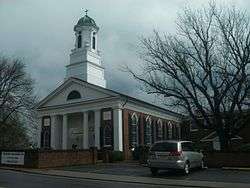St. Thomas Church (Orange, Virginia)
|
St. Thomas Church | |
 View of church, April 2017 | |
  | |
| Location | 119 Caroline St., Orange, Virginia |
|---|---|
| Coordinates | 38°14′37″N 78°6′49″W / 38.24361°N 78.11361°WCoordinates: 38°14′37″N 78°6′49″W / 38.24361°N 78.11361°W |
| Area | less than one acre |
| Built | 1833-1834, 1853, 1912, 1928 |
| Built by | Phillips, William B. |
| Architect | Jefferson, Thomas |
| Architectural style | Jeffersonian |
| NRHP Reference # | 76002115[1] |
| VLR # | 275-0008 |
| Significant dates | |
| Added to NRHP | December 6, 1976 |
| Designated VLR | February 17, 1976[2] |
St. Thomas Church is a historic Episcopal church located at Orange, Virginia, United States. It is a rectangular brick structure measuring 40 feet wide and 105 feet deep. The front facade features a recessed portico with two Doric columns flanked by two Doric pilasters. Atop the gable roof is a three-stage tower topped by an octagonal cupola. The original church building was built in 1833-1834, and measured approximately 40 feet wide and 65 feet deep. It was built by William B. Philips, a master mason employed by Thomas Jefferson during the construction of the University of Virginia. It was enlarged and improved in 1853, and enlarged again in 1912. In 1928, the rear addition was raised to a full two stories and a parish hall constructed. The original church is believed to have been based on the plans by Thomas Jefferson for Christ Church in Charlottesville, Virginia. That church was demolished in 1895.[3]
It was added to the National Register of Historic Places in 1976.[1] It is located in the Orange Commercial Historic District.
References
- 1 2 National Park Service (2010-07-09). "National Register Information System". National Register of Historic Places. National Park Service.
- ↑ "Virginia Landmarks Register". Virginia Department of Historic Resources. Retrieved 5 June 2013.
- ↑ Virginia Historic Landmarks Commission Staff (February 1976). "National Register of Historic Places Inventory/Nomination: St. Thomas Church" (PDF). Virginia Department of Historic Resources. and Accompanying photo

